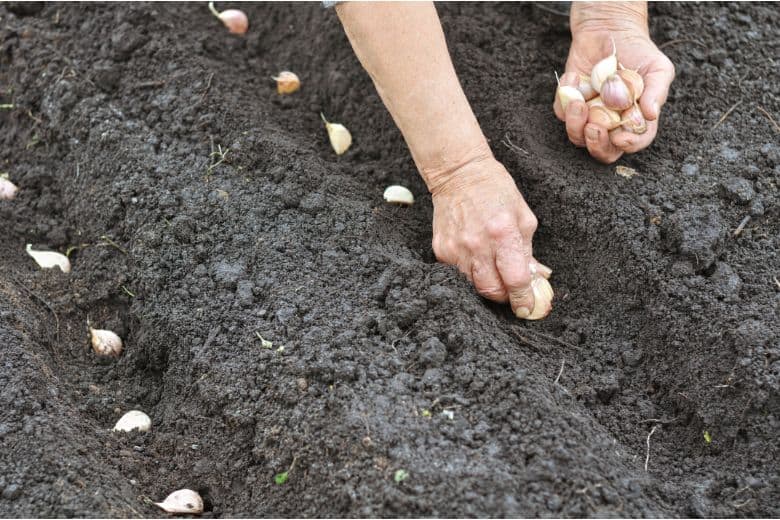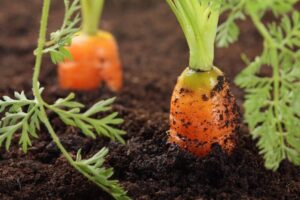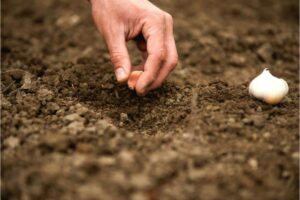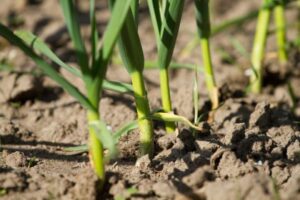
Garlic is a popular and versatile herb that is used in many dishes. Planting garlic in Oregon can be a rewarding experience for gardeners of all skill levels. Oregon has many great growing conditions, including mild temperatures, plenty of rainfall, and a long growing season. Planting garlic in Oregon will require some preparation and care, but with careful planning and attention, you can harvest a successful crop of garlic.
This article will provide an overview of how to plant garlic in Oregon, including the best time of year to plant garlic, what type of soil and location is best for growing garlic, and how to properly care for garlic plants.
Understanding Garlic Cultivation in Oregon
Garlic (Allium sativum) is a hardy crop that can tolerate Oregon’s cooler climate. This aromatic plant has a growing season that stretches from fall through late spring, thriving in full sun and well-drained soil.
Garlic is divided into two types: softneck and hardneck. Softneck garlic, typically grown in warmer climates, has a soft, pliable stem suitable for braiding. Hardneck garlic, on the other hand, is better suited for colder climates like Oregon’s, boasting a hard, woody central stalk and larger, more flavorful cloves.
Choosing the right garlic variety is crucial for success. Popular varieties that perform well in Oregon include ‘Music’, ‘German Red’, and ‘Spanish Roja’. Regardless of the variety, proper planting time, soil preparation, and care are essential for a successful harvest.
Oregon Climate and Growing Season
Climate zones: Most of Oregon is suitable for growing garlic. The Willamette Valley region has one of the best climates, as it has mild, wet winters and warm, dry summers. Garlic grows well in USDA zones 7-9, which covers much of western and central Oregon.
- Planting time: Garlic is typically planted in October or November, 4-6 weeks before the ground freezes. This allows the bulbs to be established before going dormant for winter. Planting too early runs the risk of bolting or rotting.
- Growing season: Garlic grows through the winter dormant period then shoots emerge in early spring. Leaves continue to grow through May and June. Bulbs mature and dry down through July and August. Harvest time is usually late July to early September.
- Soil: Garlic prefers moist, fertile, well-draining soil that is high in organic matter. The Willamette Valley’s fertile volcanic soil is considered excellent for growing garlic.
- Water needs: During growth periods in spring/summer, garlic needs about 1 inch of water per week from rain or irrigation. It’s important not to overwater, as wet soil can cause bulbs to rot.
- Challenges: Main problems are bolting if planted too early, rot if soil is too wet, and damage from excess rain during ripening if harvest is delayed. Overall, Oregon’s mild climate and fertile soils make it very suitable for growing hardneck and softneck garlic varieties.
How to Prepare the Oregon Soil for Planting Garlic
Garlic thrives in well-draining, fertile soil, and getting the soil prepared correctly is a key step to growing a successful garlic crop in Oregon. Here’s a step-by-step guide on how to prepare your Oregon soil for planting garlic:
1. Select the Right Location:
Garlic prefers a location with full sun, which means it should receive at least six hours of sunlight per day. A well-draining area is also crucial as garlic does not fare well in water-logged conditions.
2. Test the Soil:
A soil pH between 6.0 and 7.0 is optimal for garlic. You can purchase a soil test kit from a local garden center or online to determine your soil’s pH level. If the pH is too low (acidic), you can add lime to raise it. If it’s too high (alkaline), sulfur can help lower it.
3. Amend the Soil:
Garlic is a heavy feeder, which means it requires nutrient-rich soil to thrive. If your soil is clay-heavy or sandy, incorporate organic matter like well-rotted compost or aged manure to improve soil structure and fertility. This will help to retain moisture, improve drainage, and provide necessary nutrients for your garlic.
4. Prepare the Planting Bed:
Once your soil is amended, prepare the planting bed by loosening the soil. You can use a garden fork or tiller to break up compacted soil to a depth of about 12 inches, which allows the garlic roots to penetrate deeply and establish.
5. Apply Fertilizer:
Before planting, it’s also advisable to add a balanced slow-release fertilizer to your soil, following the manufacturer’s instructions. Garlic particularly needs high amounts of nitrogen.
6. Let the Soil Rest:
After all amendments and fertilizer have been added, allow the soil to rest for a few days before planting. This gives time for the added organic matter and nutrients to begin integrating with the soil.
By following these steps, you’ll create an ideal environment for your garlic to grow in Oregon. Remember that ongoing soil care, including regular watering and annual additions of organic matter, will continue to boost your soil’s fertility and structure, leading to healthier garlic crops year after year.
How to Plant Garlic in Oregon: A Step-by-Step Guide
Step 1: Select the Right Garlic Variety:
For the cooler climate of Oregon, hard-neck garlic varieties like ‘Music’, ‘German Red’, or ‘Spanish Roja’ are great choices.
Step 2: Choose the Right Time:
In Oregon, the ideal time to plant garlic is in the fall, preferably in October. This allows the garlic cloves to establish a robust root system before the winter.
Step 3: Prepare the Cloves:
Purchase high-quality, disease-free garlic bulbs from a reputable nursery. Separate the individual cloves from the bulb, but keep the papery husk intact around each clove.
Step 4: Prepare the Soil:
Choose a site with full sun and well-draining soil. The soil should be enriched with organic compost or aged manure and have a pH between 6.0 and 7.0. Loosen the soil to a depth of about 12 inches using a garden fork or tiller.
Step 5: Plant the Cloves:
Plant the cloves pointy end up, about 2 inches deep and 4-6 inches apart in the row, with rows spaced about 12 inches apart. The depth may need to be slightly adjusted if your soil is sandy (plant deeper) or heavy clay (plant shallower).
Step 6: Mulch the Bed:
Cover the bed with a 3-4 inch layer of organic mulch, like straw or shredded leaves. This will protect the cloves, keep the soil moist, and discourage weed growth.
Step 7: Water Regularly:
Water your newly planted garlic lightly to settle the soil. Over the winter, water sparingly, but ensure the soil doesn’t dry out completely.
Step 8: Spring Care:
As the weather warms, increase watering and consider a top-dressing of compost to feed your garlic. Look out for and promptly remove any emerging weeds.
Step 9: Harvest:
Garlic is ready to harvest in Oregon around mid-summer when the lower leaves start to brown. Loosen the soil around each bulb with a fork, then pull it up. Be gentle to avoid damaging the bulb.
Step 10: Cure and Store:
Allow harvested garlic to cure in a dry, well-ventilated area out of direct sunlight for about two weeks. Then, clean off the soil and store in a cool, dry place.
By following these steps, you’ll be well on your way to growing flavorful, aromatic garlic right in your Oregon backyard. Happy gardening!
Troubleshooting Common Issues in Garlic Growing
While growing garlic can be a straightforward process, gardeners may still face certain challenges along the way. Here are some common issues you might encounter when planting garlic in Oregon and how to troubleshoot them.
Dealing with Pests and Diseases
Garlic is generally resistant to most pests and diseases. However, a few issues might still crop up.
- White Rot: This is a serious fungal disease that affects garlic, causing yellowing and wilting of leaves, and fluffy, white fungus on the base of the bulb. To prevent white rot, practice crop rotation and avoid planting garlic in the same spot more than once every four years.
- Nematodes: Garlic can sometimes be attacked by nematodes, tiny worms that cause stunted growth and poor bulb formation. Regular crop rotation and adding organic matter to your soil can help manage nematodes.
- Onion Maggots: These pests can tunnel into garlic cloves and cause the plant to yellow and die. Using row covers and crop rotation can help deter these pests.
Addressing Nutrient Deficiencies
Garlic is a heavy feeder and requires a balanced soil to thrive. Nutrient deficiencies can lead to less vigorous plants and smaller bulbs.
- Nitrogen Deficiency: Garlic needs a good supply of nitrogen, particularly in the early stages of growth. A deficiency can cause yellowing leaves and stunted growth. To correct this, add a nitrogen-rich organic fertilizer or well-rotted manure to your soil.
- Phosphorus Deficiency: Garlic also needs phosphorus for proper bulb development. A deficiency can cause poor bulb formation. You can amend your soil with bone meal or a balanced organic fertilizer to address phosphorus deficiency.
Understanding Plant Care Challenges
Proper plant care is vital for a successful garlic crop. Here are some common care challenges you might face.
- Improper Watering: Garlic prefers moist, but not water-logged soil. Overwatering can cause bulb rot, while underwatering can lead to small bulbs. The soil should be damp to the touch but not overly soggy. During dry periods, especially in spring and early summer, regular watering is necessary.
- Incorrect Harvesting Time: Harvesting too early can result in small bulbs, while harvesting too late can cause the bulbs to split. The best time to harvest is when the lower third of the leaves have turned brown.
By understanding and addressing these common issues, you can ensure a healthy and abundant garlic harvest in your Oregon garden.
Conclusion
Planting garlic in Oregon can be a rewarding experience for gardeners. It is relatively easy to grow and can provide an abundance of flavorful bulbs when harvested. By first purchasing quality garlic cloves, preparing the soil, planting the cloves in the fall, and taking care of the plants through the winter, gardeners in Oregon can successfully grow garlic in their own gardens. With the proper care and attention, garlic can provide an abundance of flavorful bulbs that will last for many months.







